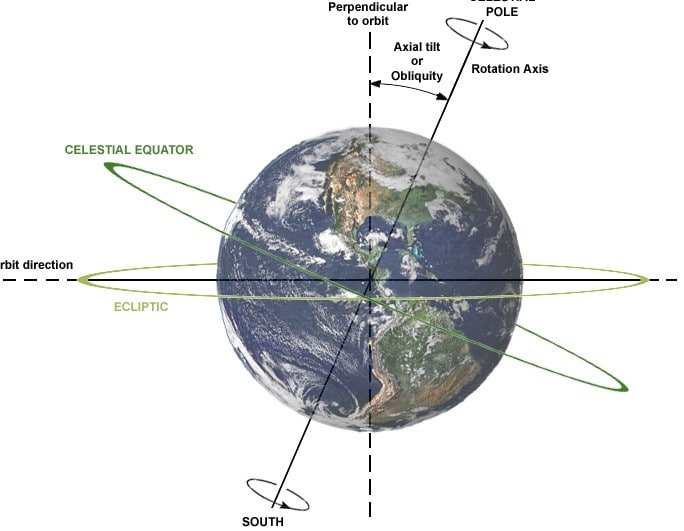
When gazing up at the heavens, it is impossible for a person to accurately gauge the distance to the stars due to the lack of perspective in the sky. This is why ancient and medieval astronomers conceptualized the notion of a “sphere of fixed stars”. They imagined the stars as being affixed to a distant celestial sphere, which, in turn, rotated around the Earth. Similarly, each of the known planets, the Moon, and the Sun were believed to have their own individual spheres.
In contemporary practices of astronomy (including astrometry and navigation), the utilization of a celestial sphere is advantageous for determining the positions of celestial bodies. Although it is not a tangible entity, the celestial sphere serves as a visual representation that allows for the projection and measurement of celestial bodies using a spherical coordinate system. The celestial equator plays a crucial role in these measurements and the conversion between different coordinate systems. Further details will be discussed below.
What is the celestial equator
When we visualize the celestial sphere, we position ourselves as observers at its center. The observer’s plumb line intersects the celestial sphere and defines two points: the zenith and the nadir. The mathematical horizon, perpendicular to the plumb line, divides the celestial sphere into two hemispheres – one that is visible and one that is not accessible for observation. It is important to note that the mathematical horizon should not be confused with the terrestrial horizon.
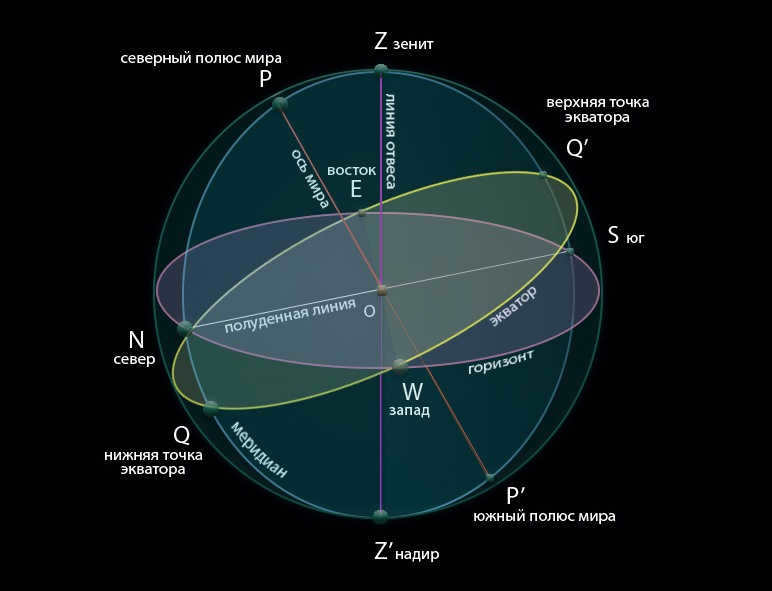
The observer also intersects with the conventional axis of the universe, which the celestial sphere rotates around. These two points of intersection are important for us – they are the north and south poles of the universe. If we imagine a plane perpendicular to the imaginary axis of the universe, we can see that it includes the celestial equator. The celestial equator is a circle that represents the Earth’s equator projected onto the celestial sphere that surrounds the Earth. Just like on our planet, where the equator divides the surface into hemispheres, the plane of the celestial equator also intersects the celestial sphere in the same way.
The Different Sides of the Earth
Both the mathematical horizon and the celestial equator are considered great circles on the celestial sphere, as their planes intersect at the center of the sphere. Another such circle is the celestial meridian. If a plane is drawn through it, it will pass through the celestial sphere at the zenith, the north pole of the Earth, the nadir, and the south pole of the Earth.
Now, let’s explore the connections between these great circles. The celestial meridian intersects the horizon at the north (N) and south (S) points. When these points are connected, a line known as the noon line is formed. This line is named so because it aligns with the direction of the shadow cast by a plumb line at noon.

The celestial equator intersects the horizon at points E and W, indicating the directions of east and west, and intersects the meridian at its highest point Q (which is closer to the zenith and positioned above the southern point) and at its lowest point Q’ (which is closer to the nadir and positioned below the northern point).
Location of the celestial equator
The position of the celestial equator, where it intersects the horizon line, can vary depending on the observer’s location on Earth. This angle is the same as the angle formed by the Earth’s axis and the plumb line.
When we are situated on the Earth’s equator, the celestial equator will be directly above us, passing through the zenith, east, nadir, and west points. However, if we are at the pole, the plane of the celestial equator will align with the plane of the horizon.

In order to ascertain the location of the celestial equator’s upper point in regions with moderate latitudes, we need to subtract the latitude of the observer from 90°. By positioning ourselves facing away from the Earth’s North or South Pole, we then need to project the resulting value along the celestial meridian from the horizon, ultimately leading us to the desired point.
Constellations on the Celestial Equator
As a result of the Earth’s axis precession, the position of the world’s poles gradually changes. Consequently, the celestial equator also shifts. This natural process introduces errors in coordinate calculations, which is why astrometry employs epochs – specific dates typically spaced 50 years apart – as reference points for star maps.
In the current astronomical epoch (J2000), the equator intersects the following constellations in the following sequence: Pisces, Cetus, Cetus, Eridanus, Taurus, Orion, Unicorn, Canis Minor, Hydra, Sextans, Leo, Virgo, Libra, Serpens, Serpens, Aquila, and Aquarius. These constellations serve as markers for locating the equatorial line in the night sky.
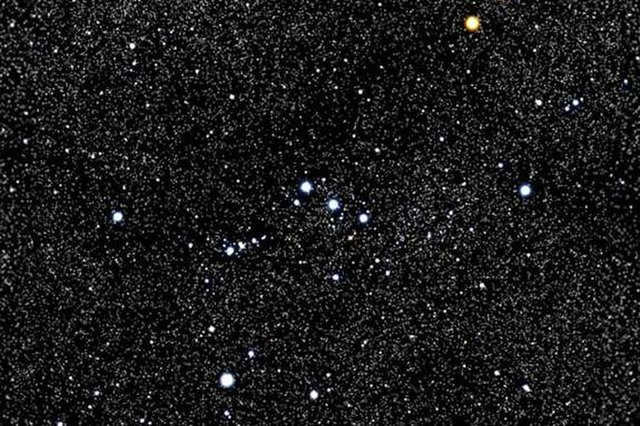
For instance, Orion is a remarkable scattering of precious gems in the winter sky. Its distinctive appearance, created by some of the most brilliant stars, is incredibly easy to identify. The celestial equator intersects this constellation near three central luminaries known as Orion’s Belt. In the summer, the constellation of Eagle can provide assistance: the celestial equator runs just below the bright Alpha of the Eagle, Altair. Therefore, these easily recognizable constellations can guide stargazers in locating the celestial equator.
Estimated reading time: 9 min
Share

- Natal Astrology
- Relationship Astrology
- Self-development and psychology
- Predictive Astrology
- Horoscopes and Predictions
- Talismans
- Soul Formula
- Numerology
- Astrological Tarot
- World Astrology
- For beginners
- For professionals
- Development of an Astrologer
Read 9 min
What is it. The celestial equator is a circle that is perpendicular to the Earth’s axis. It marks the boundary between the Northern and Southern Hemispheres.
What catches our attention? The celestial equator holds great significance for astronomers. This imaginary line plays a crucial role in determining the distance to celestial objects. Additionally, it encompasses several renowned constellations, including a few that align with the zodiac constellations.
What is the celestial equator
If we represent the celestial sphere diagrammatically, observers are positioned at the center.
Simultaneously, the plumb line that passes through them separates two points, namely the nadir and zenith. The mathematical horizon, which divides the celestial sphere into two hemispheres, one visible to the observer and the other hidden, is perpendicular to it.
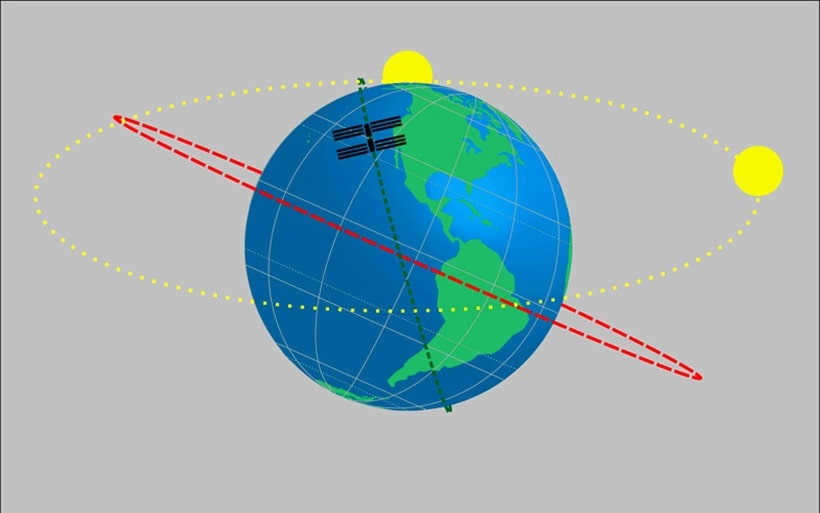
The celestial sphere itself undergoes rotation around the axis of the Earth, which passes through the observer. As a result, the celestial sphere has two points of intersection with the Earth – the North and South poles.
If we imagine a plane that is perpendicular to the imaginary axis of the Earth, it would be the celestial equator. The celestial equator is a circle that represents the projection of the Earth’s equator onto the celestial sphere. Similar to how the Earth’s equator divides its surface into two equal parts, the celestial equator divides the celestial sphere into two parts.
Location of the celestial equator
The location of the celestial equator on the Earth’s surface depends on where the observer is looking from. It is the point where the celestial equator intersects the horizon line, and the angle at which it intersects varies based on the observer’s location. This angle is equivalent to the angle between the plumb line and the Earth’s axis.
If an observer stands on the Earth’s equator, the celestial equator will be directly overhead, passing through the zenith, east, nadir, and west points. However, for someone standing at the pole, the plane of the celestial equator and the horizon will coincide.
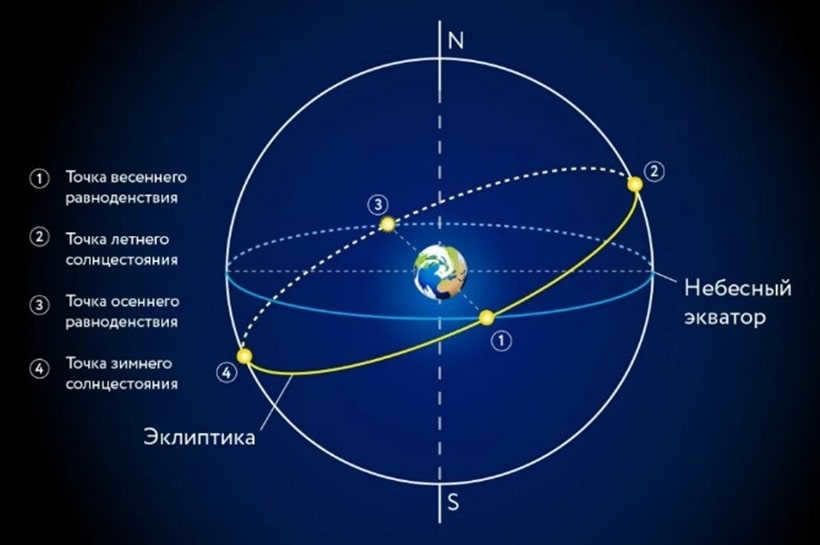
In order to find the celestial equator’s highest point in mid-latitudes, one must subtract their latitude from 90 degrees. Once this value is obtained, it should be placed on a celestial meridian from a celestial horizon, positioning it with the world pole at their back.
Celestial equator and the line of the horizon
The horizon line is crossed by the celestial equator at points E (east) and W (west), and by the celestial meridian, which passes through the poles of the world and the zenith, at points N (north) and S (south). The angular distance between the horizon and a specific point on the celestial sphere, such as a star, is called altitude, and it is measured in degrees (-90 to +90 below and above the horizon).
This measurement is similar to declination in the equatorial coordinate system, except that the two systems are rotated at a certain angle relative to each other.
For instance, let’s say we are observing from the North Pole. In this case, the North Pole of the Earth will be directly above us, known as the zenith, and the line connecting us to the North Pole will align with the Earth’s axis. However, as we move, the line will shift by the same number of degrees of geographic latitude. As a result, the height of the North Pole (hp) above the horizon will be equal to the geographic latitude (ϕ) of our current location.
Movement of the celestial equator
When considering the movement of the celestial equator from the perspective of an observer on Earth, it is important to note that this plane remains fixed while all celestial bodies move relative to it.
There are several fascinating facts regarding the motion of celestial bodies as observed from the Earth’s equator:
- The rising and setting of any star will occur perpendicular to the horizontal plane.
- A celestial body (such as a star) will spend exactly 50% of its orbit visible above the equator line.
- The ecliptic only intersects the celestial equator at the fall and spring equinoxes, which happens twice a year.
The celestial sphere and its relation to the equator
The celestial sphere is a concept that refers to an imaginary sphere surrounding the Earth. It is used to represent the positions of celestial objects in the sky. One important feature of the celestial sphere is the plane of the celestial equator, which is a circular plane that is perpendicular to the Earth’s axis. This plane divides the celestial sphere into two halves: the southern half and the northern half. By using the coordinates obtained from the celestial equator, astronomers can accurately locate and track celestial bodies.

It is important to mention that the physical existence of the entire line and plane of the celestial equator is non-existent and cannot be observed, as they are purely imaginary. The concept of the celestial equator was introduced to facilitate the process of locating celestial bodies, providing convenience and efficiency. Furthermore, the plane and line may vary in relation to the observer.
The position of the ecliptic and the celestial equator
The ecliptic is inclined at an angle of 23°27'8" to the plane of the celestial equator. This means that the ecliptic and the celestial equator are not aligned and form an angle of 23 degrees 27 minutes and 8 seconds. In astronomy and geography, a minute is equal to 1/60th of a degree, and a second is equal to 1/60th of a minute.
It is important to note that the angle of inclination is related to the Earth’s orbital motion. The Earth’s axis of rotation is tilted by 23°27'8" in relation to its orbit around the Sun. This tilt can be observed on globes, which are models of the Earth, as they also have a slight tilt.
Similar to the equator, the ecliptic divides the sphere into two parts and has two poles.
The celestial equator, similar to the equator on Earth, divides the celestial sphere into two hemispheres. Just like Earth has two poles, the celestial sphere also has two poles – the north pole and the south pole. In the constellation of the Dragon, the north pole of the celestial sphere is located at a latitude of 23°27’8″ from the North Pole of the world.
In astronomy, the ecliptic plane is the main plane used in the ecliptic celestial coordinate system. It is similar to the equatorial plane, but instead of being calculated from the celestial equator, it is calculated from the ecliptic. The ecliptic is an imaginary line that represents the yearly path of the Sun as seen from Earth. It is tilted at an angle of 23°27’8″ to the celestial equator.
The ecliptic plane and the equatorial plane are both important in astronomy for determining the positions of celestial objects. By using these coordinate systems, astronomers can accurately locate and track objects in the sky.
Constellations along the celestial equator
The celestial equator is a dividing line that splits the celestial sphere into the southern and northern hemispheres. The constellations that cross this equator are the most prominent in the night sky. They can be seen from almost anywhere on Earth, although not throughout the entire year. This is because they are positioned north of the southern circumpolar constellations and south of the northern constellations.
Out of the 15 constellations along the celestial equator, some of them are zodiacal. However, it is important not to confuse these with the constellations that lie along the ecliptic. The ecliptic is the path that the Sun appears to follow against the backdrop of the stars throughout the year. Astrologers take the zodiacal signs into account when constructing a birth chart.
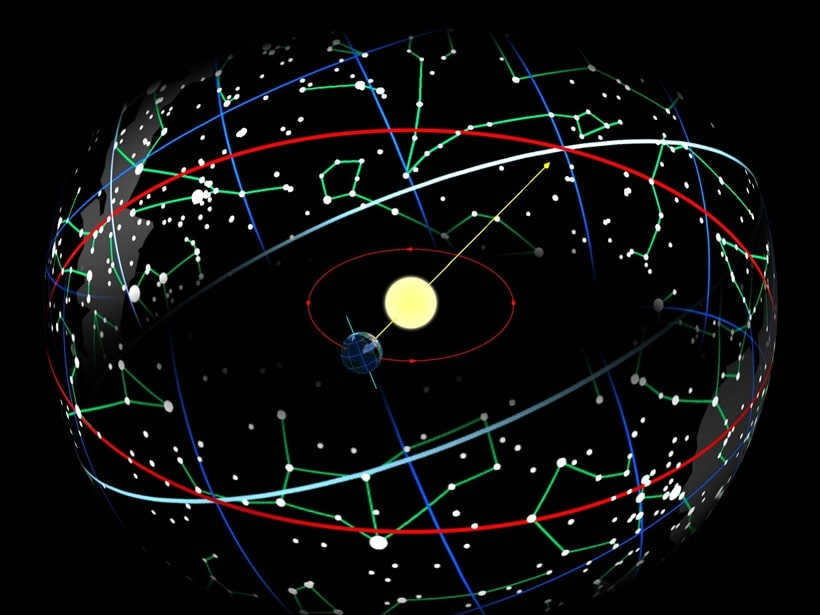
Hydra
Hydra is considered the largest constellation located in the southern celestial hemisphere, containing several hundred galaxies. The primary star in this constellation is Alfard. Additionally, observers can also witness Jupiter’s Ghost, a planetary nebula, as well as a cluster of stars and sub-stellar objects in Hydra and the surrounding constellations. The best time to observe Hydra is from February through March.
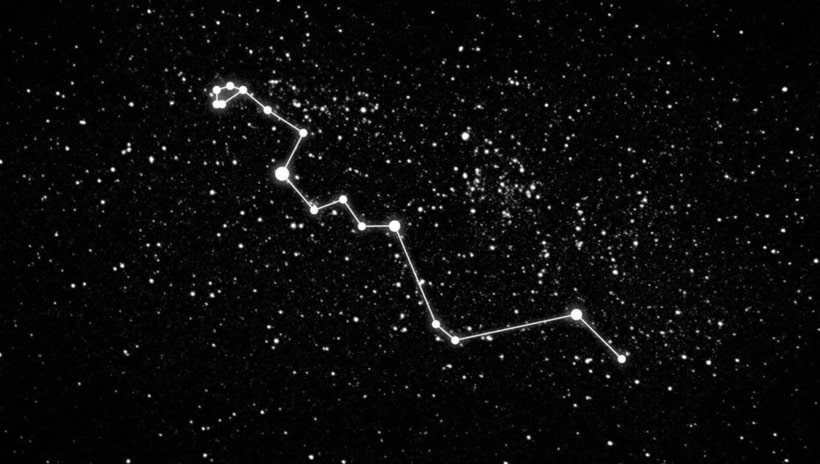
Virgo
Virgo is situated on the ecliptic and is the second largest constellation in terms of size, covering 1,294 square degrees. It is also home to the point of the fall equinox at the current moment.
Within Virgo, there are notable galaxies such as the Eye, Sombrero, the Siamese Twins, and 3C 273, which is the brightest quasar in the sky. The best time to observe these objects in the constellation is between March and April.
Whale
The constellation in the southern hemisphere is the fourth largest.
There are a total of 170 stars in the constellation that can be observed without the need for any special equipment. Among these stars, Beta Keith is the brightest and is currently undergoing a transformation into a red giant. Another star similar to the Sun is Tau Kita. It is worth mentioning that the HD11964 star system contains two exoplanets that resemble Earth.
In addition to stars, the Whale constellation also contains several galaxies, including Holmberg 15A, which harbors a supermassive black hole at its center. The best time to observe this constellation is during the months of October and November.
Eridanus
This constellation is situated in the first quadrant of the southern hemisphere. It encompasses the Eridanus super void, also known as the Cold Spot of relic radiation. The brightest star in Eridanus, Ahernar, can be observed in the southern direction. It is intriguing to note the scarcity of microwave radiation and absence of galaxies in this particular area of outer space. The explanation for this immense void remains elusive within the framework of standard cosmology.
It is noteworthy that even in ancient times, astronomers in Greece were aware of the existence of this celestial region, as evidenced by their early references to it.
It is highly probable that the constellation received its designation due to its resemblance to a river, as it possesses a rather considerable magnitude and elongated form. According to the ancient Greek mythology, the appellation Eridanus (a body of water, a river) frequently appears in reference to it. The optimal time for observing the constellation is during the month of November.
Aquarius
Aquarius is home to several supergiant stars, including Sadalmelik (Alpha Aquarius) and Sadalsuud (Beta Aquarius). This constellation can be found in the fourth quadrant of the southern hemisphere. Additionally, Aquarius is where you can find the Saturn Nebula, which is known for its vibrant green color and strong ultraviolet radiation emitted by its central star.
Another planetary nebula found within Aquarius is the Snail, which is often referred to as the “Eye of God” due to its distinctive appearance. The best time to observe Aquarius is during the months of August and September.
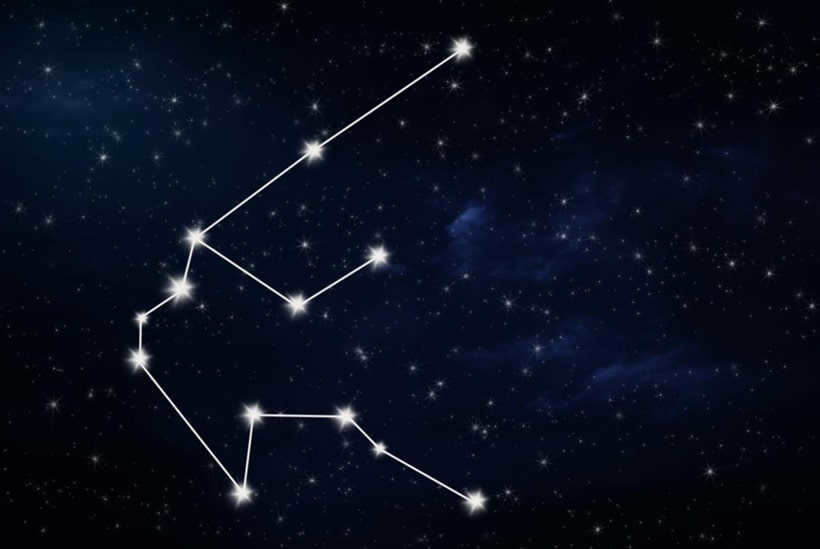
Serpens
The constellation Serpens, situated in the southern hemisphere, is famous for its repeated attempts to be included among the zodiacal constellations. The ideal time to observe it is during the summer season, specifically in the month of June. Among its celestial objects are globular clusters and nebulae.
This is also where the most recent supernova star was observed, discovered by astronomer I. Kepler in 1604 and named in his honor. Serpens is one of the four constellations with the highest number of stars with variable brightness, as it contains over 2,500 of them.


Leo
Leo is a group of 11 stars, with the brightest one being Regulus (Alpha Leo), located in the northern part of the sky. This star system resembles a pair of rabbits, one white and one red, and its brightness fluctuates periodically. Additionally, there is a large exoplanet in this star system, which is a gas giant.
Leo also contains various galaxies, including spiral and elliptical galaxies like M105, which has a supermassive black hole at its core. The best time to observe Leo is during the months of February and March.
Pisces
Pisces is a zodiacal constellation that can be found in the northern hemisphere. It is often divided into a northern part and a western part, with Arab astronomers referring to the western part as the Crown. Pisces is situated between the constellations of Aries and Aquarius. One grouping of stars is located under Andromeda, while the other is positioned between Pegasus and Aquarius. Although they are commonly referred to as two asterisms, they are considered part of the Pisces constellation.
The Pisces constellation, which is situated in the first quadrant of the northern hemisphere, can be further categorized into two groups of stars: the Northern group and the Western group. It is worth noting that the point of the vernal equinox is currently located within this constellation. Notable objects within Pisces include the colliding pair of galaxies Arp 284, the Dwarf galaxy, and the ghost galaxy. The brightest star in Pisces is known as Piscium. The best time for observation is during the months of September and October.

Taurus
Situated in the first quadrant of the northern hemisphere, the Taurus constellation is renowned for its stars Elnath, Aldebaran (the brightest), and Asciona. Additionally, within this constellation lies the Crab Nebula, which features a pulsar that periodically emits electromagnetic radiation, as well as the Pleiades star cluster, which hosts numerous sources of X-ray radiation. It is recommended to observe Taurus during the period between November and December.
Eagle
The Eagle constellation can be found in the northern hemisphere, with its western part situated to the east of the Milky Way. It is easily identifiable by its stars Altair, Tarazed, and Alshain, which form a distinctive straight line, outlining the shape of an eagle’s neck, back, and left shoulder. Additionally, this constellation is home to the remarkable astronomical object SS433.
SS433 is a unique double object consisting of a giant-sized star that orbits a source of X-rays. The best time to observe the Eagle constellation is during the months of June to August.
Constellation Serpens
The constellation Serpens splits the serpentine cluster into two sections, with the “head” remaining in the northwest and the “tail” in the east.
The tail of Serpens contains the Eagle Nebula featuring the Pillars of Creation gas (an area where stars are formed from cosmic dust and hydrogen). The “Head of Serpens” consists of a cluster of six galaxies known as the Seyfert Sextet, four of which eventually merge, along with M5, one of the oldest globular clusters in the Milky Way. It can even be seen with the naked eye, but the sky must be extremely dark. The best time to observe the objects in the Serpens constellation is in June.

Orion
Situated in the first quadrant of the northern hemisphere, the constellation Orion boasts a plethora of fascinating astronomical phenomena. One notable star within this constellation is Betelgeuse (Alpha Orion), a red giant that is rapidly shedding its mass. It is predicted that Betelgeuse will soon reach the end of its stellar life cycle and explode as a supernova.
Another intriguing feature of Orion is the Trapezium cluster, which is formed from a nebula and consists of multiple stars. Positioned above this cluster is Orion’s Belt, which is home to massive stars like Alitak, Mintaka, and Alnilam. The ideal time to observe not only the Trapezium cluster but the entire constellation of Orion is between the months of November and January.
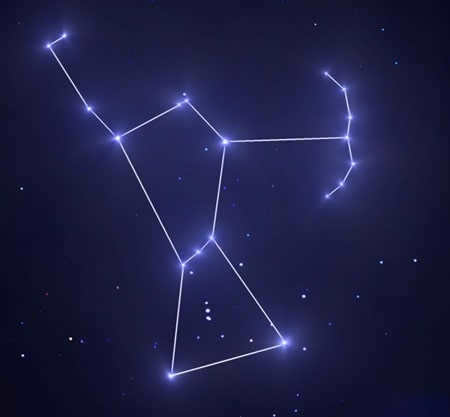

The Unicorn Constellation
Situated within the triangle formed by the stars Sirius, Betelguese, and Procyon in the second quadrant of the northern hemisphere, the Unicorn constellation may be small in size but it boasts several noteworthy celestial objects. Among these are the massive paired stars known as Plaskett, the variable star V408 (which experiences periodic changes in brightness), the triple star Beta Unicorn, and the scattered cluster M50. The best time to observe these objects, as well as the constellation itself, is during the month of February.
Sextant
Sextant is a small and faint constellation found in the second quadrant of the southern hemisphere.
It is a relatively dim and compact constellation situated in the southern hemisphere within the second quadrant. The brightest star in Sextant is known as Alpha Sextantus. Additionally, this constellation offers the opportunity to observe the CR7 galaxy, which is recognized as one of the most distant and oldest in the Universe. Moreover, there is a galactic quasar present, featuring a supermassive black hole at its core, formed from the merger of two smaller galaxies. The optimal time for observing Sextant is during the month of March.

celestial equator – a large circle on the celestial sphere that is perpendicular to the axis of the Earth and coincides with the Earth’s equator. The celestial equator divides the celestial sphere into two hemispheres: the northern hemisphere with its apex at the north pole of the Earth, and the southern hemisphere with its apex at the south pole of the Earth. The constellations that the celestial equator passes through are known as equatorial constellations.
Due to the tilt of the Earth’s axis in relation to the plane of its orbit, the plane of the ecliptic is inclined at an angle to the plane of the celestial equator.
23°26'. The intersection of the ecliptic and the celestial equator occurs at the vernal and autumnal equinoxes. The point of the vernal equinox is widely accepted as the starting point for direct ascent, which is equivalent to geographic latitude.
During the epoch J2000.0, the celestial equator passes through the following constellations:
- Find reputable sources that support the statements made.
- Include visual representations.
Wikimedia Foundation . 2010 .
Explore different definitions of “celestial equator” in various dictionaries:
CELESTIAL EQUATOR – a major circle on the Celestial Sphere, situated halfway between the Celestial Poles and in the same plane as the Earth’s equator … Scientific and Technical Encyclopedic Dictionary
celestial equator – the major circle of the celestial sphere, whose plane is perpendicular to the axis of the Earth. EdwART. Explanatory Naval Dictionary, 2010 … Nautical Dictionary
celestial equator – [http://slovarionline.ru/anglo russkiy slovar neftegazovoy promyishlennosti/] Topics oil and gas industry EN celestial equator … Technical Translator’s Handbook
The celestial equator is an imaginary line in the sky that is located above the Earth’s equator. It represents the intersection of the celestial sphere by a plane that passes through its center and is perpendicular to the axis of the world. This line divides the celestial sphere into the Northern and Southern hemispheres. It is defined in various dictionaries as follows:
- Celestial equator – The great circle of the celestial sphere, with a plane that is perpendicular to the axis of the world. (Source: Astronomical Dictionary)
- Celestial equator – The great circle of the celestial sphere that divides it into two hemispheres. All points on this circle are 90 degrees away from the poles of the world. (Source: Dictionary of Many Expressions)
EQUATOR – (Latin, derived from aequus meaning equal). A theoretical line that bisects the Earth’s surface, dividing it into two equal hemispheres: northern and southern; line of equinox. A lexicon of foreign terms adopted into the Russian language. Chudinov A.N., 1910. EQUATOR… … Lexicon of Foreign Terms in the Russian Language
EQUATOR – EQUATOR, the designation of specific theoretical circles. The Earth’s equator is situated equidistant between the north and south poles, effectively separating the globe into the Northern and Southern hemispheres; it serves as the reference line for geographical measurements… … … Scientific and Technical Encyclopedic Dictionary
EQUATOR – EQUATOR, equator, man. (Latin. aequator, lit. equalizer). 1. A fictitious line that divides the Earth or the sky into two distinct halves: the southern hemisphere and the northern hemisphere (geogr., ast.). Earth’s equator. Celestial equator. 2. Any imaginary line encircling the Earth, … … Ushakov’s Explanatory Dictionary
Celestial equator – The celestial sphere is divided by the celestial equator. The celestial sphere is a hypothetical auxiliary sphere with an arbitrary radius onto which the stars and other celestial objects are projected: it is used to solve various astronomical problems. The center of the celestial sphere, as … … Wikipedia
Constellations that Cross the Celestial Equator
This term describes constellations that are intersected by the celestial equator.
Interestingly, these constellations are not widely known. Unlike the zodiac constellations, for instance. This could be due to the fact that they do not hold any predictive or promising qualities.
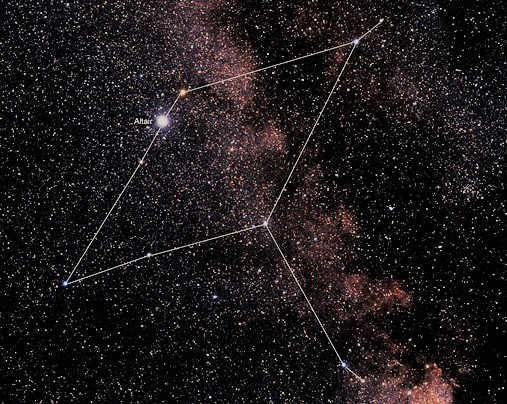
The Eagle constellation
To gain a better understanding, it is important to recall the concept of the equator. There are both celestial and terrestrial equators, with the specific one being determined by what is being observed and the path it traverses.
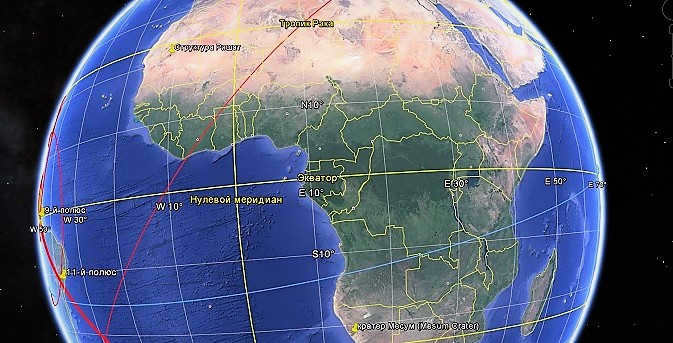
Earthly Equator
A celestial equator is a large circle on the celestial sphere that is perpendicular to the Earth’s axis. It coincides exactly with the Earth’s equator, but it divides the sky into two parts, not the Earth. This division creates the northern and southern hemispheres.
As we know, the Earth rotates around its axis, which is slightly tilted relative to the plane of its orbit. Interestingly, a similar tilt is observed at the celestial equator in relation to the ecliptic plane.
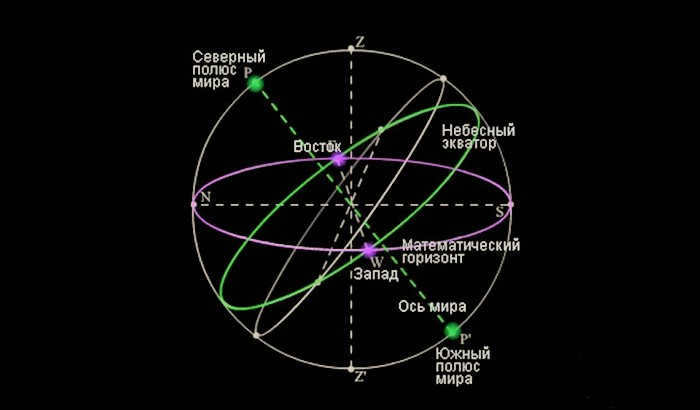
The celestial equator
However, there is still a point where the two intersect. We refer to these points as the vernal and autumnal equinoxes, depending on the time of their crossing.
However, the uniqueness of the night sky is such that it always evokes a sense of wonder and longing in those who gaze at it. Could it be that we truly originate from a different place?
Boris Akunin. Jade rosary
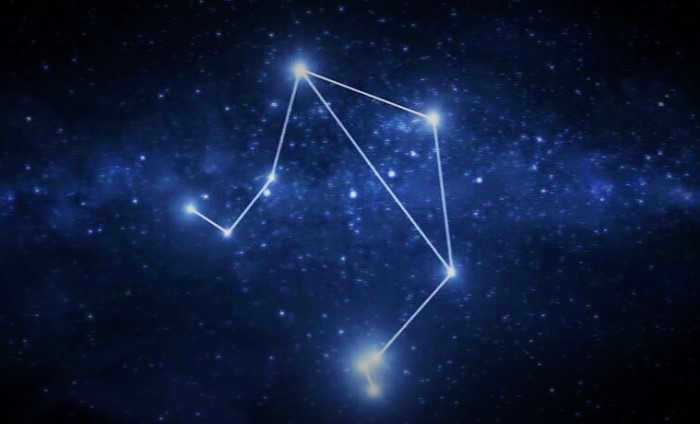
The constellation Libra
The equatorial constellations have the following names:
- Pisces,
- Kit,
- Taurus,
- Orion,
- Unicorn,
- Eridanus,
- Little Dog,
- Aquarius,
- Hydra,
- Leo,
- Sextant,
- Virgo,
- Eagle,
- Snake,
- Serpentor.
Naturally, the celestial constellations are equally captivating and intriguing components of outer space. Moreover, their designation facilitates and enhances the exploration of the Universe.
When one gazes up at the vast expanse of the sky, it becomes apparent that estimating the distance to the stars is a futile task. The lack of a discernible perspective in the sky makes it impossible for a person to accurately gauge the vastness of space. This is why ancient and medieval astronomers conceptualized the idea of a “sphere of fixed stars”. According to this view, the stars were believed to be affixed to a distant celestial sphere that encircled the Earth. This celestial sphere was thought to rotate along with the stars, planets, the Moon, and the Sun, each of which had its own individual sphere.
What is the celestial equator
The celestial equator is a significant feature of the celestial sphere, which we can observe as observers placed at its center. It is defined by the plane perpendicular to the plumb line passing through the observer and the celestial sphere. This plane divides the celestial sphere into two hemispheres – one that is accessible for observation and another that is inaccessible. It is important to note that the celestial equator should not be confused with the terrestrial horizon.
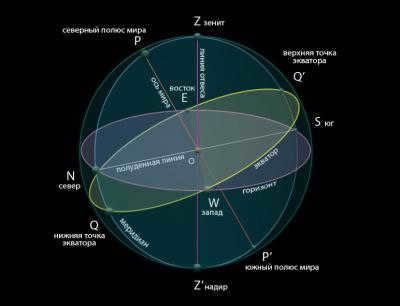
The observer also experiences the passage of the conventional axis of the globe, around which this sphere rotates. These two points of intersection, the poles of the globe (north and south), are of particular importance. We can envision a plane perpendicular to the imaginary axis of the globe, to which the celestial equator belongs. This circle is a projection of the Earth’s equator onto the celestial sphere that envelops our planet. On Earth, the equator divides the surface into hemispheres, and similarly, the plane of the celestial equator intersects the celestial sphere.
Sides of the Earth
Both the mathematical horizon and, of course, the celestial equator are known as great circles of the celestial sphere, as their planes intersect at its center. Another circle of this kind is the celestial meridian. If a plane is drawn through it, it will intersect the celestial sphere at the zenith, the north pole of the Earth, the nadir, and the south pole of the Earth.
Let’s now explore the relationship between great circles. The celestial meridian intersects the horizon at the north (N) and south (S) points. Connecting these points forms a line known as the noon line. It is called so because at noon, it aligns with the shadow created by a plumb line.

Points E and W on the horizon indicate the intersection of the celestial equator, while point Q represents its highest point where it is closer to the zenith and positioned above the southern point. Similarly, point Q’ represents the lowest point of the celestial equator, closer to the nadir and situated below the northern point.
The angle at which the celestial equator intersects the horizon line (the same angle formed by the Earth’s axis and the plumb line) may vary; its specific value is determined by the observer’s location on the surface of the Earth.
When located on the Earth’s equator, the celestial equator will be directly overhead. It will pass through the zenith, east, nadir, and west points. If we are standing precisely at the pole, the plane of the celestial equator will align with the plane of the horizon.

To find the location of the celestial equator’s upper point in middle latitudes, we need to subtract the observer’s latitude from 90°. If we stand facing away from the North Pole, we should move the obtained value along the celestial meridian from the horizon, and we will locate the desired point.
Equatorial star groupings
As time passes, the Earth’s axis undergoes precession, causing the positions of the world’s poles to gradually shift. The celestial equator also moves in response to this phenomenon. This shifting process can result in errors when calculating coordinates, which is why the field of astrometry introduced the concept of epochs – specific dates typically spaced 50 years apart – to which star charts are attached.
In the current astronomical epoch (J2000), the equator passes through the following constellations in the given sequence: Pisces, Cetus, Cetus, Eridanus, Taurus, Orion, Unicorn, Canis Minor, Hydra, Sextans, Leo, Virgo, Libra, Serpens, Serpens, Aquila, and Aquarius. These constellations can be used as reference points for locating the celestial equator in the night sky.
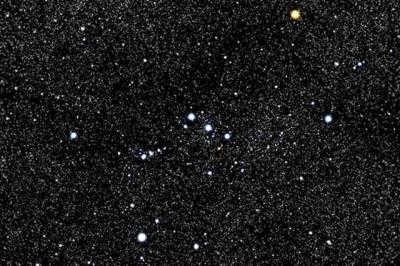
For instance, in the winter sky, Orion is a stunning collection of stars. Its unique appearance, created by some of the most brilliant stars, is easily identifiable. The constellation Orion’s Belt, consisting of three central luminaries, is intersected by the celestial equator line. In the summer, the constellation Eagle can serve as a guide: the celestial equator runs just below the bright star Alpha of the Eagle, known as Altair. Therefore, by observing these recognizable constellations, one can determine the location of the celestial equator.
The celestial equator is a significant circle formed by the intersection of the celestial sphere and the Earth’s equator plane.
The celestial equator is the point where the Earth’s equator intersects with the celestial sphere. The ecliptic is the point where the Earth’s orbit (the path it takes around the Sun) intersects with the celestial sphere.
The arc of the celestial equator from the vernal equinox to its ascending point E determines the time of sunrise, as does the corresponding arc of the ecliptic from the vernal equinox to its ascending point.
The celestial equator intersects with the vernal and autumnal equinoxes.
The Sun also intersects with the celestial equator at the vernal and autumnal equinoxes.
As is well known, the height of a celestial equator pole above the horizon in a given geographical point is equal to its geographical latitude.
To determine the point on the horizon where the given star and the celestial equator intersect at the same time, we can use the known arc 0E. The direct ascension of this point will be equal to the direct ascension of the star (denoted as ‘a’).
This discussion revolves around the ecliptic, which is a large circle on the celestial sphere that is inclined to the celestial equator. It is along this path that the Sun appears to move. The Moon and planets also have visible paths that are close to the ecliptic.
The path of the Sun, known as the ecliptic, intersects the celestial equator at two specific points. At one of these points, when the Sun aligns with the Earth’s axis, day and night are of equal length all around the world. This phenomenon is known as the equinox. The entire celestial sphere, including the zodiac and the Sun, undergoes a gradual rotation around the ecliptic axis, which is perpendicular to its plane. This rotation affects all celestial objects, including stars located near the north-south axis, which is connected to the Earth and forms an angle of 231 / 3 with the ecliptic axis. As a result of this motion, the star Polaris, which is currently close to the north-south axis, will eventually move away from it, and another star will take its place in the sky. This means that in several centuries, a different bright star will be observed in the position that is currently occupied by Polaris. Over the past forty centuries, from the time of the construction of the pyramids to the present day, a significant shift has occurred due to this rotation. By studying the tunnels in the pyramids that were designed to observe the star Sirius at midnight on the vernal equinox, we can estimate the approximate time when the pyramids themselves were built.
SPRING EQUINODENCE POINT – a specific point on the celestial sphere where the celestial equator intersects with the ecliptic.
When gazing at the sky, it is impossible for a person to accurately gauge the distance to the stars due to the absence of perspective. This is why ancient and medieval astronomers conceptualized the “sphere of fixed stars” as a key element. They believed that the stars were affixed to a distant ideal sphere, rotating around the Earth alongside it. Each of the planets, the Moon, and the Sun were thought to have their own individual spheres.
When it comes to determining the positions of celestial bodies in modern astronomy (astrometry and navigation), the use of a celestial sphere is highly advantageous. While the celestial sphere itself does not physically exist, it serves as a visual representation where the positions of stars are projected and measured using a spherical coordinate system. In these measurements and the conversion between coordinate systems, the celestial equator plays a crucial role. Further details on this topic will be discussed below.
When we look at the diagram of the celestial sphere, we will see ourselves positioned at the very center. Two points on the surface of the celestial sphere, known as zenith and nadir, are marked by the plumb line that passes through the observer. It’s important to note that the mathematical horizon, which is different from the terrestrial horizon, can be found on the plane that is perpendicular to the plumb line. This horizon divides the celestial sphere into two hemispheres, one that is accessible for observation and one that is not.
The conventional axis of the world, around which this sphere rotates, also passes through the observer. There are two important points on this axis – the north and south poles of the world. If we imagine a plane perpendicular to the imaginary axis of the world, the celestial equator would belong to this plane. The celestial equator is a circle that represents the projection of the Earth’s equator onto the celestial sphere that surrounds our planet. Just like how the equator divides the Earth’s surface into hemispheres, the plane of the celestial equator intersects the celestial sphere in a similar manner.
Dimensions of the Earth
Both the mathematical horizon and the celestial equator are known as great circles of the celestial sphere because they pass through its center. Another great circle is the celestial meridian. If we imagine a plane passing through it, it will intersect the celestial sphere at different points, marking the zenith, the north pole of the Earth, the nadir, and the south pole of the Earth.
Now let’s explore the relationships between these great circles. The horizon intersects the celestial sphere at the north and south points, forming a line known as the meridian. This line is called the noon line because at noon, it aligns with the shadow cast by a plumb line.

The celestial equator intersects the horizon at points E and W, representing east and west, and intersects the meridian at its highest point Q (which is closer to the zenith and located above the southern point) and at its lowest point Q’ (closer to the nadir, located below the northern point).
Where can the celestial equator be found?
The angle at which the celestial equator intersects the horizon line (same angle as the Earth’s axis and the plumb line) varies; its numerical value depends on the observer’s position on the Earth’s surface.
When located on the Earth’s equator, the celestial equator will be directly above our heads. It will pass through the zenith, east, nadir, and west points. If we are exactly at the pole, the plane of the celestial equator will coincide with the plane of the horizon.

To find the location of the upper point of the celestial equator in middle latitudes, we need to subtract the observer’s latitude from 90°. When facing away from the North Pole, we then need to measure the resulting value along the celestial meridian from the horizon to locate the desired point.
Equatorial constellations
Over time, the position of the Earth’s poles gradually changes, causing the celestial equator to shift accordingly. This phenomenon introduces errors in the calculation of coordinates, which is why astrometry uses epochs – specific dates typically separated by 50 years – to attach star maps to.
In the current astronomical epoch (J2000), the celestial equator intersects the regions of the following constellations in the following order: Pisces, Cetus, Eridanus, Taurus, Orion, Monoceros, Canis Minor, Hydra, Sextans, Leo, Virgo, Libra, Serpens, Serpens Caput, Aquila, and Aquarius. These constellations can be used to locate the celestial equator in the sky.
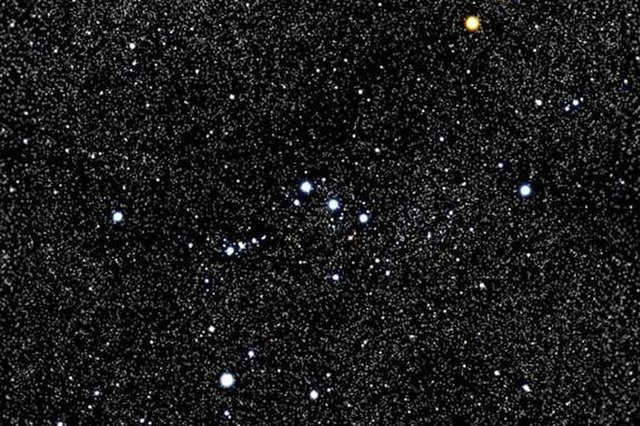
For instance, Orion presents itself as a magnificent collection of sparkling stars in the winter sky. Its distinct shape, formed by some of the most brilliant stars, is easily recognizable. The constellation Orion’s Belt, made up of three central luminaries, intersects with the celestial equator line. In the summer, the celestial equator runs just below the bright star Alpha Eagle, also known as Altair. Therefore, by observing these familiar constellations, one can determine the location of the celestial equator.
The celestial equator divides the celestial sphere into two hemispheres: the northern hemisphere whose apex is at the North Pole, and the southern hemisphere whose apex is at the South Pole. The constellations that the celestial equator passes through are referred to as equatorial constellations.
References
Summary describing the celestial equator
– Why don't you join the military?
– After Austerlitz! – Prince Andrei said gloomily. – No, thank you. I made a promise to myself that I would not serve in the active Russian army. And I wouldn’t, even if Bonaparte were here at Smolensk, threatening the Bald Mountains. I told you before," Prince Andrew continued, calming down. – Now I am in the militia. My father is the commander-in-chief of the 3rd district, and the only way for me to avoid serving is to be with him.
– So you’re in the service?
– Yes, I am. – He was silent for a moment.
– So why do you serve?
– Well, here’s why. My father is one of the most remarkable men of his time. But he’s getting old, and while he’s not cruel, he is too active. He is afraid of his own habit of having unlimited power, and now he has been given this power by the Emperor as the commander-in-chief of the militia. If I had been two hours late two weeks ago, he would have hanged the protocolist in Yukhnov," Prince Andrew said with a smile; "so I serve because no one has influence over my father except me, and I want to save him from an act that would torment him later.
– Ah, now I understand!
– Yes, mais ce n’est pas comme vous l’entendez, [but it is not as you understand it,]" Prince Andrew continued. – I did not want and do not want any good for that scoundrel of a protocolist who stole some boots from the militia; I would even be very content to see him hanged, but I pity my father, or rather myself.
Prince Andrew became more and more animated. His eyes glittered feverishly as he tried to prove to Pierre that he never acted with the good of his neighbor in mind.
– ‘Well, here you want to free the peasants,’ he went on. – That’s very noble; but not for you (I don’t think you have detained anyone and sent them to Siberia), and even less for the peasants. If they are beaten, whipped, and sent to Siberia, I don’t think they are any worse off. In Siberia, they live the same life as cattle, their scars heal, and they will be as happy as they were before. It’s the people who morally perish, feel remorse, suppress that remorse, and become brutalized by having the power to decide right and wrong. It is these people that I pity, and for whom I would like to free the peasants. You may not have seen it, but I have seen how good people, raised in these traditions of unlimited power, become more irritable, cruel, and rude as the years go by, and they can’t help it, and they become more and more unhappy. – Prince Andrew said this with such passion that Pierre couldn’t help but think that these thoughts were influenced by his father. He didn’t respond to him.
CELESTIAL SPHERE 1: THE CELESTIAL EQUATOR
In earlier times, astronomers held the belief that all stars were connected to an imperceptible sphere known as the celestial sphere, which encompassed the Earth. This can be seen in the diagram provided. The Earth rotates on its axis at a consistent pace, completing a full rotation every 24 hours, equivalent to 15 degrees per hour. This is because a complete rotation of the Earth covers 360 degrees. Ancient astronomers were of the opinion that the Earth remained stationary at the center of the celestial sphere. They believed that the sphere made a consistent revolution every 24 hours, dragging the fixed stars along with it.
Two coordinates determine the position of a star on the celestial sphere. The angle between the direction from the center of the celestial sphere to a particular star and the plane of the celestial equator is known as declination. Stars situated north of the celestial equator have a positive declination, while stars situated south of the celestial equator have a negative declination. The second coordinate, known as direct ascension, is the angle between the first point of Aries (Y), a specific point on the celestial equator, and the great circle of declination passing through that star. This coordinate corresponds to Earth’s longitude.
The measurement of Direct Ascension is typically expressed in hours, representing the time span between the moment when the first point of Aries crosses the observer’s meridian (the imaginary line running from north to south through the point directly above the observer and Polaris) and the moment when a star crosses the observer’s meridian from east to west. In simpler terms, direct ascension is calculated in terms of hours, but in the opposite direction of the stars’ rotation.
For further information, please refer to the article on sidereal and solar time.
This passage is sourced from the book “Encyclopedic Dictionary (X-Y)” written by Brockhaus F. A.

